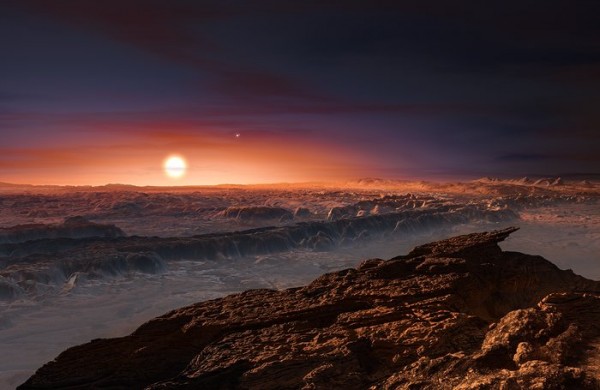By Ana Verayo, | February 10, 2017

This artist’s impression shows a view of the surface of the planet Proxima b orbiting the red dwarf star Proxima Centauri, the closest star to its Solar System.
Astronomers have always been searching extraterrestrial life outside our solar system. Hunting alien worlds that can potentially host life can become complex but now, scientists have devised a system where they can determine the habitability of an exoplanet. Despite this, the closest Earth-like planet, Proxima b, may not be habitable at all.
Like Us on Facebook
When observing distant star systems, astronomers identify whether the planet is in the habitable zone of its system. This location is also known as the "Goldilocks Zone" which is not too near or not too far from its parent star, similar to Earth's current location from the sun. When an exoplanet is in this habitable zone, scientists believe that the planet can harbor the ideal conditions for liquid water to flow, thus creating a desirable climate for life to flourish.
In this new study, astronomers challenge this criteria of a planet's habitability. More specifically, scientists question if Proxima b which is the closest Earth-like planet, can host life and possess the conditions for life to emerge and thrive. A team of NASA scientists now suggest that in order to determine if an exoplanet in the habitable zone can support life, they also need to consider the heat and light emission of their parent star.
According to lead author of the study, solar scientist Vladimir Airapetian of NASA's Goddard Space Flight Center, if we want to successfully find an exoplanet that can develop and sustain life, we must identify what kind of stars can become the best parents. During the study, researchers observed red dwarfs which are the oldest stars in the universe.
This would also mean that the these stars also have planets that are orbiting them for the longest time. They then focused this study to Proxima Centauri, which is the closest star to the sun and is also considered as a red dwarf. Proxima b is also orbiting this red dwarf.
According to co-author of the study, William Danchi of NASA's Goddard Space Flight Center, red dwarfs are also more prone to powerful stellar eruptions than our sun. This means that the habitability for these exoplanets might be compromised, since there are a lot of other factors to balance out.
These red dwarf eruptions are high energy X-ray and ultraviolet emissions similar to solar storms that can strip away a planet's atmosphere. Those planets near red dwarfs can suffer from these powerful energy emissions, that can ionize atmospheric gases.
Scientists then developed new models to simulate the atmospheric conditions of exoplanets orbiting red dwarfs. They discovered that red dwarf stars can emit so much high energy radiation that can trigger this ionization, resulting in escaping oxygen and nitrogen gases.
According to co-author of the study, Alex Glocer from NASA's Goddard Space Flight Center, when there is more X-ray and powerful ultraviolet energies emitting from their sun, the atmosphere of an exoplanet can suffer from this ion escape due to more electrons generated. This also means that how much energy a star emits can strongly influence and determine if a planet is indeed a habitable one.
-
Use of Coronavirus Pandemic Drones Raises Privacy Concerns: Drones Spread Fear, Local Officials Say

-
Coronavirus Hampers The Delivery Of Lockheed Martin F-35 Stealth Fighters For 2020

-
Instagram Speeds Up Plans to Add Account Memorialization Feature Due to COVID-19 Deaths

-
NASA: Perseverance Plans to Bring 'Mars Rock' to Earth in 2031

-
600 Dead And 3,000 In The Hospital as Iranians Believed Drinking High-Concentrations of Alcohol Can Cure The Coronavirus

-
600 Dead And 3,000 In The Hospital as Iranians Believed Drinking High-Concentrations of Alcohol Can Cure The Coronavirus

-
COVID-19: Doctors, Nurses Use Virtual Reality to Learn New Skills in Treating Coronavirus Patients







